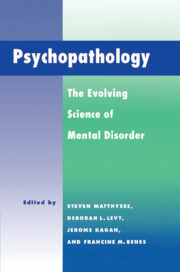Book contents
- Frontmatter
- Contents
- List of Contributors
- Preface
- Brain mechanisms
- Development
- 7 Editor's introduction: Methods in the developmental study of madness
- 8 Developmental psychopathology: From attribution toward information
- Comments on Sheldon H. White's chapter
- 9 A paradoxical partnership: Some historical and contemporary referents linking adult schizophreniform disorder and resilient children under stress
- 10 A look at the evolution of developmental models of schizophrenia
- 11 Developmental theory: Lessons from the study of risk and psychopathology
- 12 The return of the ancients: On temperament and development
- Thinking
- Genetics
- Response and reflections
- Author index
- Subject index
8 - Developmental psychopathology: From attribution toward information
Published online by Cambridge University Press: 04 May 2010
- Frontmatter
- Contents
- List of Contributors
- Preface
- Brain mechanisms
- Development
- 7 Editor's introduction: Methods in the developmental study of madness
- 8 Developmental psychopathology: From attribution toward information
- Comments on Sheldon H. White's chapter
- 9 A paradoxical partnership: Some historical and contemporary referents linking adult schizophreniform disorder and resilient children under stress
- 10 A look at the evolution of developmental models of schizophrenia
- 11 Developmental theory: Lessons from the study of risk and psychopathology
- 12 The return of the ancients: On temperament and development
- Thinking
- Genetics
- Response and reflections
- Author index
- Subject index
Summary
As we generally conceive of developmental psychopathology, it encompasses a number of more or less discrete and clearly defined disabilities of behavior, just as is the case for adult psychopathology. On the one side, children manifest disabilities coming from a clear and distinct physical source; the disabilities are of a kind most likely to be found in all times and cultures. On the other side, developmental psychopathology includes problems of disturbance and maladjustment that arise from the peculiar situation of children and youth growing up in twentieth-century American society. While one can, in the abstract, easily characterize these two broad sources of childhood problems, it is still no easy matter to confront a particular child in trouble and to find causes, sources, and points of address for that trouble.
During the twentieth century, theory and practice in developmental psychopathology have moved steadily away from the “disease model” framework and toward transactional models that address the stresses and risks entailed in the growing child's adjustment to family, school, peers, and community. We deal in this chapter with only the first slow, awkward steps in the development of a body of American conceptions and understanding of childhood psychopathology – from the turn of the century, when any and all problems of children might be attributed to the dark shadow of degeneracy, to the early 1930s, when the beginnings of significant research on children began to give a less dogmatic, more informed, more complex and more confusing picture of children and their problems.
- Type
- Chapter
- Information
- PsychopathologyThe Evolving Science of Mental Disorder, pp. 161 - 197Publisher: Cambridge University PressPrint publication year: 1996
- 1
- Cited by



